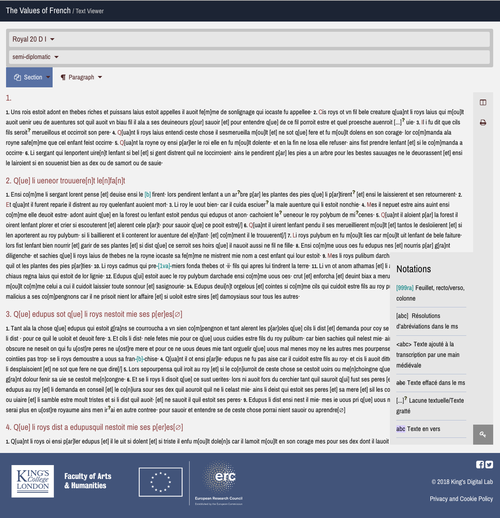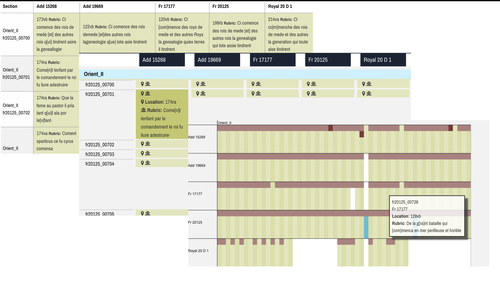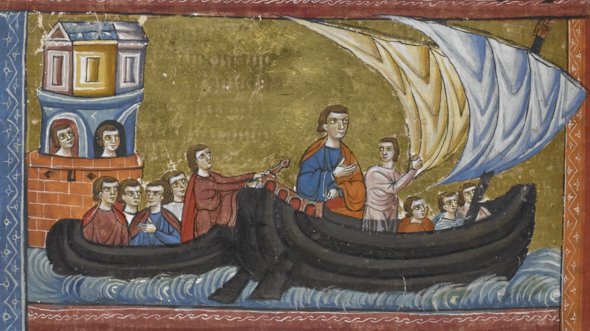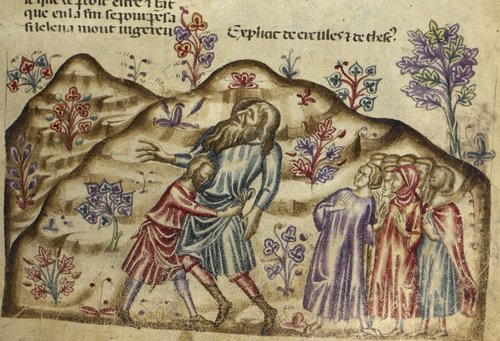What’s new at TVOF?
We are at the beginning of a crucial year for our project, which runs 2015-20, and we would like, in this first blog of the new academic year, to share with you some key developments on our website and to announce a major conference we are organising with the British Library next June.
A new text: London, British Library, Royal 20 D I
The complete semi-diplomatic transcription of London, BL, Royal 20 D I is now online. Compiled in Naples (ca. 1330s), it preserves a revised version of the Histoire ancienne jusqu’à César (usually labelled the ‘second redaction’), in which the Genesis and Alexander sections are absent and the Trojan section is substituted by Prose 5 (a long early 14th-century and composite account of the Trojan War based on the Roman de Troie by Benoît de Sainte-Maure). Through these modifications, the Histoire ancienne is less universal in scope, and becomes a tale of two cities: Troy, defeated and destroyed, and Rome, founded by the Trojans’ offspring and destined to rule the whole world. The second redaction is the product of 14th-century Neapolitan culture, and, tailored as it is to different tastes and visions of how history should be written, the most important modification of the Histoire ancienne. Our semi-diplomatic transcription of London, BL, Royal 20 D I provides access for the first time to the text of the second redaction in its entirety, allowing scholars to explore one of the most important achievements of medieval Francophonia.
In the next few months, we will publish interpretive editions of additional sections from both Paris, BnF, f. fr. 20125 and London, BL, Royal 20 D I.

The new Text Viewer
New tools 1: Text Viewer 2.0
As part of the publication of the semi-diplomatic transcription of Royal 20 D I, we have also added new functionalities to the Text Viewer. These include:
• the rendering of additions and modifications in the semi-diplomatic transcription (which is particularly pertinent to the Royal manuscript)
• the addition of information about medieval marginal annotations
• the highlighting of verse with a background colour and the addition of line numbers
In addition, images of the miniatures have been incorporated into the text of Paris, BnF, f. fr. 20125 and the notes are now accessible in the print screen viewing option of the interpretive edition.
New tools 2: Alignment
Alignment is a new tool developed by Paul Caton, Ginestra Ferraro and Geoffroy Noël of King’s Digital Laboratory, which charts and allows users to navigate different manuscripts of the Histoire ancienne jusqu’à César. It provides the location and basic information about each paragraph of the text (according to how the text is divided in Paris, BnF, f. fr. 20125).
Alignment was initially conceived as an internal tool for the TVOF team: to align the text in the two manuscripts we are editing, and additionally, to record information about the contents of other Histoire ancienne manuscripts. However, given its evident usefulness to colleagues working on this lengthy textual tradition, we have now decided to make it freely available on our website.

The three visualisations of Alignment
Alignment is available in three visualisations (‘Column’, ‘Table’ and ‘Bars’), which give users access to different kinds of data: it is possible to focus on details (using ‘Column’ or ‘Table’) or have a comprehensive view of entire sections (using ‘Bars’). In all three visualisations, users can locate each paragraph of the Histoire ancienne jusqu’à César and immediately access basic information (such as the text of each rubric and the presence/absence/prosification of verse sections). At the moment, we have made public the alignment of five manuscripts (Paris, BnF, f. fr. 20125; London, BL, Royal 20 D I; London, BL, Add. 15268; London, BL, Add. 19669; Paris, BnF, f. fr. 17177), but more will follow over the next few months.
Please let us know any feedback you might have on the updates to the Text Viewer and the new Alignment tool. Do not hesitate to contact us if you have any suggestions or remarks.

Jason and the Argonauts (London, BL, Additional 15268, f. 105v). Reproduced with the permission of the British Library board.
International conference, June 2019: ‘Narrating history across languages in Medieval Europe’
On 14th and 15th June 2019, KCL and the British Library will host an international conference organised by the TVOF team. The conference will have a strong interdisciplinary approach: building on our focus on the usage of French in the Mediterranean context, we will discuss why and how historical memory developed and was transmitted across different languages throughout the Middle Ages. Thanks to our speakers, we hope to present a complex panorama, in which medieval Francophone culture will be placed in dialogue with Latin, Arabic, German, Greek and Hebrew traditions. More information is available on our website.

Hercules' single combat with the giant (London, BL, Royal 20 D I, f. 26r). Reproduced with the permission of the British Library board.
Treasures of the British Library: two Histoire ancienne manuscripts on display
We are delighted to announce the exhibition of two important Histoire ancienne manuscripts in the British Library’s Sir John Ritblat Treasures Gallery: Royal 20 D I (our ‘second-redaction’ manuscript, copied in Naples in the 1330s), and Additional 15268 (a first-redaction manuscript, produced in Acre before 1291). Curated by three PGRs affiliated with TVOF, Melek Karatas, Matt Lampitt, and our project student Henry Ravenhall, the case introduces the importance of the Histoire ancienne and its wide dissemination across the Mediterranean. The selected openings focus on the story of Hercules (from the Greeks and Amazons section) and give a taste of the striking visual programmes of Royal 20 D I and Additional 15268.